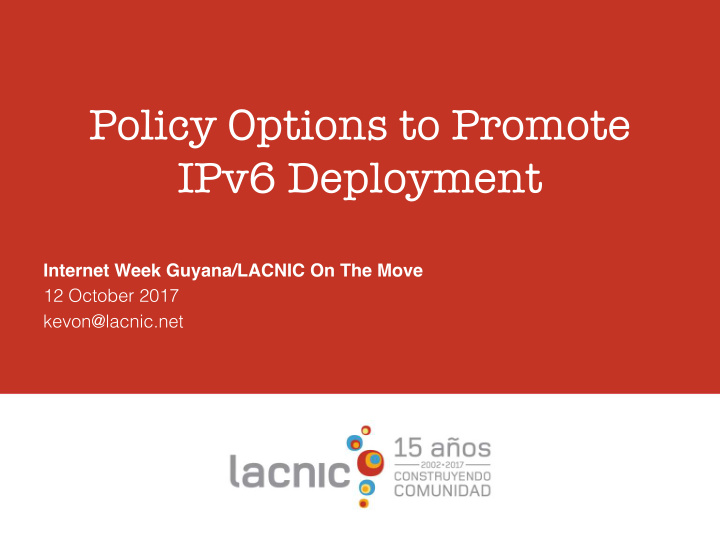



Policy Options to Promote IPv6 Deployment Internet Week Guyana/LACNIC On The Move 12 October 2017 kevon@lacnic.net
The new, larger version of the Internet: IPv6 • Video url: https://www.youtube.com/watch?v=- Uwjt32NvVA
Trends
Available IPv4 /8s In Each RIR AFRINIC APNIC ARIN LACNIC RIPE NCC 0.9 0.83 0.75 0.6 0.37 0.3 0.26 0.00 0 Source: NRO
Percentage of Members with both IPv4 and IPv6 in each RIR AFRINIC APNIC ARIN LACNIC RIPE NCC 100% 90% 89.41% 80% 70% 73.88% 60% 55.48% 50% 54.10% 40% 35.50% 30% 20% 10% 0% Source: NRO
Measurements and references for IPv6 deployment • LACNIC Labs http://portalipv6.lacnic.net/w p-content/caf-lacnic/CAF- • ICAv6 LACNIC-IPv6-Deployment- Social-Economic- Development-in-LAC.pdf
IPv6 Adoption in the Caribbean LACNIC Caribbean - IPv6 Adoption wrt Total Internet Traffic 20 18 17.64 16 14 12 10 8 6 4 2 0 0 0.33 0 0 1.01 0 0 0 0.02 0 0 AW BQ BZ CU CW DO GF GY HT SR SX TT
IPv6 Availability in the Caribbean LACNIC Caribbean - No. of IPv6 Allocations (/48-End Users; /32-ISPs) 40 37 35 30 24 25 20 17 15 11 10 10 7 6 5 5 5 5 3 2 0 AW BQ BZ CU CW DO GF GY HT SR SX TT ISPs /32 = 79,228,162,514,264,337,593,543,950,336 End Users /48 = 1,208,925,819,614,629,174,706,176
IPs in Guyana Guyana: • Population:735,000(est.Jul-2016) • MobileSubscriptors:550,000(est.Dec-2015)~75% • InternetPenetration:305,000(est.Mar-2017)~40% Internet Addresses: • IPv4: 60,000 (Today) ~ 5.1 users have to share 1 Internet address (avg). • IPv6: 3,600000,000000,000000,000000,000000 • Up to 17 Million subscribers
Policy problem(s) • Despite availability, IPv6 is not being deployed locally which may be attributed to a perceived lack of demand, low awareness, and/or other factors. • Testing of IPv6 has occurred locally but IPv6 traffic was not permanently enabled. • Presently, Internet users remain vulnerable because of a lack of traceability of IPs due to excessive CGNAT. • This situation, if left unattended, will create significant obstacles to Internet growth.
Case for Action • Consideration 1: There is insufficient measurement and research on planning phases, which makes it difficult to determine the real status quo of IPv6 adoption • Consideration 2: Measured end-user internet behaviours usually cover accessed Internet services (e.g. Alexa stats), but not enough is known about user communities and potential Internet developments (gaming, next-gen application development, cloud-based enterprise services). The scope for measuring content and end- user activities could be adjusted • Consideration 3: Nevertheless, low deployment stats require multi-actor interventions judging Y-O-Y trends and understood remits of ISPs
Caution • Bottom-up, open, transparent policy process to enhance trust • Avoid unnecessary “administrative burden” to existing ISPs (state requirements for PTTNS players as prescribed under Telecommunications, Fair Trade and Company laws) • Avoid having strategic decisions only contemplate financial/accounting reasoning • Understand policy and legal framework and particularly the need to be flexible
Policy objective • Measurement and monitoring of IPv6 deployment • Exponential improvement of IPv6 deployed and available to the end-user • Enabling environment to facilitate: – Regular end-user QoS – High-end user activities – Potential investment opportunities for Guyana-based Internet services available globally (could target the Guyanese diaspora in the first instance) • Influence IPv6 uptake by stimulating awareness and demand
Profile of actions
Compendium of policy and legal instruments in the region Country Authority Instrument Scope Target Mexico Instituto Federal de Advisory Council Regulator and public Internet of Things Telecomunicaciones (IFT) Recommendation of sector (IoT) 8 nov 2016 Cuba Ministerio de Comunicaciones Parliamentary National Gov’t & national resolution network efficiency; Nos.181/2016; importation of goods 140/2008 using IP Costa Rica Ministerio de Cienca, Directive N° 049- Public sector Gov’t network Tecnología y MICITT of 2013 efficiency Telecomunicaciones (MICITT) Colombia Ministerio de Tecnologías de Parliamentary Public sector Gov’t network la Información y las resolution No. 2710 efficiency; Comunicaciones (MINTIC) of 2017 procurement Ecuador Ministerio de Ministerial decree Public sector Gov’t network Telecomunicaciones y No. 680 of 2012 efficiency; enable .ec Sociedad de la Información websites Dominican Instituto Dominicano de Managerial Council Public sector Gov’t network Republic Telecomunicaciones Resolution No. 021- efficiency; (INDOTEL) 15 procurement; awareness Peru Secretaría de Gobierno Digital Supreme Decree Nº Public sector Gov’t network (SEGDI) 081-2017-PCM efficiency; e-gov; procurement
IPv6 Mobilisation • An IPv6 Task Force (TF) is a not-for-profit working group that coordinates efforts to promote the deployment of IPv6 in a country or region • True IPv6 TFs must be multistakeholder (ISPs, IXP, government, regulator, academia, OEMs, etc.) • There are TFs in Brazil, Argentina, Colombia, Uruguay, Panama, Cuba, Mexico and Peru among others • FLIP6 and LAC IPv6 Task Force: http://portalipv6.lacnic.net/en/flip6-and-lac-ipv6-tf/
IPv6 Awareness Activities in the region Country Organisers Mexico Universidad Nacional Autónoma de México (UNAM) Venezuela Universidad Centroccidental Lisandro Alvarado (UCLA) Dominican Republic Universidad APEC Argentina University Interconnection Network (RIU) and ISOC Argentina Peru Universidad de la Pacífica and ISOC Peru Costa Rica ISOC Costa Rica http://www.worldipv6launch.org
Questions?
Ways to keep in touch!
Recommend
More recommend